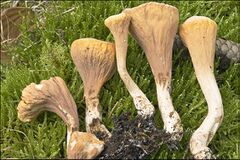Biology:Clavariadelphus truncatus
| Clavariadelphus truncatus | |
|---|---|

| |
| Scientific classification | |
| Kingdom: | |
| Division: | |
| Class: | |
| Subclass: | |
| Order: | |
| Family: | |
| Genus: | |
| Species: | C. truncatus
|
| Binomial name | |
| Clavariadelphus truncatus (Quél.) Donk
| |
| Synonyms | |
|
Clavariadelphus borealis V.L. Wells & Kempton | |
Clavariadelphus truncatus is a species of mushroom. The common name of the species is truncated club[1][2][3][4] or club coral.[5] It is a member of the basidiomycete fungi family Gomphaceae.
Description
The species has a yellow-orange fruiting body in the shape of a club with a flat cap.[6] The flesh is white, thin, and hollow at the top.[7] The vertical side of the fruiting body normally has folds and wrinkles, but can be smooth. The spores are smooth and their spore print is pale yellow to ochre.[8]
The mushroom has a pleasant odor and a sweet taste.[7]
Similar species
Although one field guide says that it is unlikely that anyone would confuse the mushroom with another species,[9] the yellow chanterelle is distantly related to the mushroom and looks nearly the same, except for the ridges and cross-veined hymenium.[10] Clavariadelphus pistillaris is also similar, but the top is not flat.[6]
Habitat
The mushroom's habitat is in coniferous forests from summer to autumn.[7] The mushroom is a common species.[11] The species is found at a high elevation and is widely distributed.[12] C. truncatus can bioaccumulate significant amounts of zinc,[13] and radioactive caesium-137.[14]
Edibility
The mushroom is edible and has a sweet taste.[7] Old mushrooms may be spongy and soft inside.[15] The species is high in nutrition and can be used for cooking.[16] One field guide says that the mushroom is one of the best to eat and has a sweet flavor that is especially appealing to some people.[17] David Arora writes that the mushroom can be sauteed and served for dessert.[18]
Medicinal uses
The mushroom contains clavaric acid, which has been shown to reduce the rate of tumor development when given to mice.[19] Clavaric acid interferes with farnesyltransferase, an enzyme implicated in tumorigenesis, which suggests that clavaric acid may have therapeutic value in the treatment of certain cancers.[19] It has been reported that mushrooms have significant antioxidant activity.[20]
See also
- Medicinal mushrooms
References
- ↑ "Clavariadelphus truncatus · truncated club". The British Mycological Society. https://www.britmycolsoc.org.uk/library/english-names.
- ↑ "Clavariadelphus truncatus · truncated club". EOL. https://eol.org/pages/190328.
- ↑ "Clavariadelphus truncatus · truncated club". NBN Atlas. https://species.nbnatlas.org/species/NBNSYS0000020722.
- ↑ "Truncated Club (Clavariadelphus truncatus)". Ninaturalist.nz. https://inaturalist.nz/taxa/55160-Clavariadelphus-truncatus.
- ↑ "Clavariadelphus truncatus (Quél.) Donk – Truncate Club Coral, Truncated Pestle". botany.cz. https://botany.cz/en/clavariadelphus-truncatus/.
- ↑ 6.0 6.1 Trudell, Steve; Ammirati, Joe (2009) (in en). Mushrooms of the Pacific Northwest. Timber Press Field Guides. Portland, OR: Timber Press. pp. 239. ISBN 978-0-88192-935-5. https://books.google.com/books?id=WevHvt6Tr8kC.
- ↑ 7.0 7.1 7.2 7.3 Miller Jr., Orson K.; Miller, Hope H. (2006). North American Mushrooms: A Field Guide to Edible and Inedible Fungi. Guilford, CN: FalconGuide. pp. 343. ISBN 978-0-7627-3109-1.
- ↑ C. Roody, William (2003). Mushrooms of West Virginia and the Central Appalachians. Kentucky: University Press of Kentucky. pp. 408. ISBN 978-0-8131-9039-6. https://books.google.com/books?id=5HGMPEiy4ykC&q=Clavariadelphus+truncatus&pg=PA408.
- ↑ Authors, Multiple (1992). Edible Wild Mushrooms of North America: A Field-To-Kitchen Guide. Texas: University of Texas Press. pp. 114. ISBN 978-0-292-72080-0. https://books.google.com/books?id=zsJN7NZutTAC&q=Clavariadelphus+truncatus&pg=PA114.
- ↑ "Clavariadelphus truncatus". California Fungi. http://www.mykoweb.com/CAF/species/Clavariadelphus_truncatus.html.
- ↑ "Clavariadelphus truncatus". University of Guelph. http://www.uoguelph.ca/~gbarron/CORAL/clavdelp.htm.
- ↑ Stucky Evenson, Vera (1997). Mushrooms of Colorado and the Southern Rocky Mountains. Big Earth Publishing. pp. 165. ISBN 978-1-56579-192-3. https://books.google.com/books?id=EAeDeyqZLq0C&q=Clavariadelphus+truncatus&pg=PA165.
- ↑ Gonen, TF; Yamac M, Cabuk A, Yildiz Z, M; Cabuk, A; Yildiz, Z (2008). "Selection of newly isolated mushroom strains for tolerance and biosorption of zinc in vitro". Journal of Microbiology and Biotechnology 18 (3): 483–489. PMID 18388466.
- ↑ Gaso, MI; Segovia N, Morton O, Lopez JL, Machuca A, Hernandez E, N; Morton, O; Lopez, JL; Machuca, A; Hernandez, E (2007). "Radioactive and stable metal bioaccumulation, crystalline compound and siderophore detection in Clavariadelphus truncatus". Journal of Environmental Radioactivity 97 (1): 57–69. doi:10.1016/j.jenvrad.2007.03.003. PMID 17466420.
- ↑ Smith, Alexander Hanchett; Weber, Nancy S. (1980). The mushroom hunter's field guide. Michigan: University of Michigan Press. pp. 79. ISBN 978-0-472-85610-7. https://books.google.com/books?id=TYI4f6fqrfkC&q=Clavariadelphus+truncatus&pg=RA1-PA79.
- ↑ Persson, Olle (1998). The chanterelle book. Ten Speed Press. pp. 78. ISBN 978-0-89815-947-9. https://books.google.com/books?id=AGRF3tqnCgsC&q=Clavariadelphus+truncatus&pg=PA78.
- ↑ Authors, Multiple (1998). A Field Guide to Mushrooms: North America. Houghton Mifflin Harcourt. pp. 72. ISBN 978-0-395-91090-0. https://books.google.com/books?id=kSdA3V7Z9WcC&q=Clavariadelphus+truncatus&pg=PA72.
- ↑ Arora, David (1986). Mushrooms Demystified: A Comprehensive Guide to the Fleshy Fungi. Ten Speed Press. pp. 634. ISBN 978-0-89815-169-5. https://archive.org/details/mushroomsdemysti00aror_0. "Clavariadelphus truncatus."
- ↑ 19.0 19.1 Jayasuriya, Hiranthi; Silverman, Keith C.; Zink, Deborah L.; Jenkins, Rosalind G.; Sanchez, Manuel; Pelaez, Fernando; Vilella, Dolores; Lingham, Russell B. et al. (1998). "Note Clavaric Acid: A Triterpenoid Inhibitor of Farnesyl-Protein Transferase from Clavariadelphus truncatus". Journal of Natural Products 61 (12): 1568–1570. doi:10.1021/np980200c. PMID 9868169.
- ↑ Sevi̇ndi̇k, Mustafa (2018-10-25). "Investigation of Oxidant and Antioxidant Status of Edible Mushroom Clavariadelphus truncatus" (in en). Mantar Dergisi 9 (2): 165–168. doi:10.30708/mantar.427457. https://dergipark.org.tr/en/pub/mantar/issue/39914/427457.
External links
- Healing-mushrooms.net Image & description of bioactive properties
Wikidata ☰ Q320428 entry
 |

